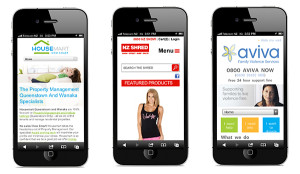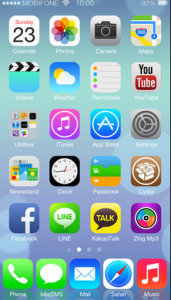The late/great Albert Einstein once said “I never think about the future, it comes soon enough.” True enough for some, Al, but when it comes to web design and business, we think it’s smart and necessary to think about the future in order to succeed. As we all know, change happens fast, and in the worlds of web design, business and technology, it happens even faster. To be good web designers and business operators, we need to stay on trend and stay current. To be excellent at what we do, it’s necessary to identify trends before they hit. 
With the advance in mobile technology in the last few years, it’s no surprise that more and more people are using their mobile devices to access the Internet. How is it then that the vast majority of businesses are still not mobile user-friendly? Can I be frank? If you’re a business owner and you don’t have an online presence that is accessible via mobile you’re missing out on major business opportunities. There’s nothing complex about having a mobile presence. The answer is so simple:Responsive Web Design. So, what is it exactly?
Responsive web design is a web design style that crafts websites with the aim of providing an optimal viewing experience. These websites are easy to read and even easier to navigate across a wide range of devices by being coded in a way that uses a minimum of resizing, panning and scrolling, thus making it a very user-friendly style. Happy users are happy customers and happy customers spend more money. This is what we call conversion. So, how do you get the most out of your responsive design?
Ring! Ring!
When it comes to creating a mobile website, you have two options: Responsive Design and Mobile Templates. Responsive design is easier in that it requires only one website that is coded in order to adapt to all screen sizes and therefore accessible through multiple devices. Mobile templates aren’t as friendly. They require an entirely separate mobile-only website. You can see why this is a problem! It’s more work, more money and more hassle.
Consider this:
- More people are using their mobiles for Google searches
- 25% of Internet users access it on a mobile device
- 25% of all emails are opened on mobile phones
- 61% of people have a better opinion of brands when they offer a good mobile experience
Keeping customers happy is paramount to a successful business so providing a positive user experience should be a top priority. If someone lands on your mobile website and doesn’t find what they’re looking for easily they’re likely to leave your site for your competitor. A positive experience on mobile devices can translate into more profits as the customer is 67% more likely to purchase your services or products if it’s fast and easy to do so.
Keeping Google Happy
It’s a well-known fact that Google prefers responsive web design over mobile templates. Just like your customers, Google wants to be able to navigate your site and organise the content with ease. With responsive design your site has one URL and the same HTML across any device making it easier for users to share and engage with the content compared to sites with different pages for mobile and desktop users. Google knows that unhappy customers will go to other sites which then results in an increase in bounce rates and lower ranking on mobile searches. Beware: Google’s external link algorithm then gets cranky and this can have serious consequences for your SEO.
Back to the Future
One of the best characteristics of responsive design is that the size of the template is designed based on screen size and not specific devices. Technology is in a state of flux at all times. New devices are dreamed up and created faster than you can say “Eight Track Player”. Your responsive website won’t be made obsolete with the advent of new technology. It will stay current and beautiful which saves you money because you won’t need to tweak it. Speaking of money…
Responsive Design: How Much Does It Cost?
Depending on your current website, changing it to a responsive design may cost a few hundred dollars or a few thousand. That’s assuming the existing design lends itself to becoming responsive. If you haven’t redesigned your website in the last several years it’s quite probable that you’ll need to go through a complete redesign process. As designers we know that the cost depends on how much work you want to get done. If you’re interested in converting your existing site to responsive design, we can help. Just get in touch with one of our designers and they can talk you through the process. If you’re looking to stay competitive in the marketplace, you’re going to have to make the leap to responsive design.
Call me: The Future Is Mobile
Going ‘responsive’ can present challenges for website owners but without a mobile-friendly website the future of your online presence is bleak. If you’re not providing a mobile-friendly experience for your customers, they’ll bounce off your website and go to your competitor whose website is easier to use. Haven’t you ever done that before yourself? I know I have. The future, as we all know, is mobile. People prefer their mobile devices over desktop and laptop computers. Consider this fun fact: by 2017 5 billion people will use mobile phones. Can you afford to stay in the Dark Ages of web design? Nope.
There are, however, some exceptions to the rule:
- Your business doesn’t depend on your website to operate. (Lucky you!)
- Your business has absolutely no competitors in the marketplace. (Um, really?!)
- You’re totally familiar with responsive design, you know that it’s not the right fit for your business and you have an alternative mobile strategy. (Fair enough.)
If any of these 3 points resonate with you, then you have nothing to worry about. If not, get in touch. We’re here and we’re ready to update your website to be responsive. Welcome to the future.





